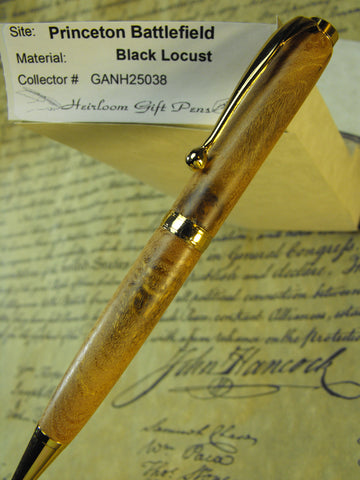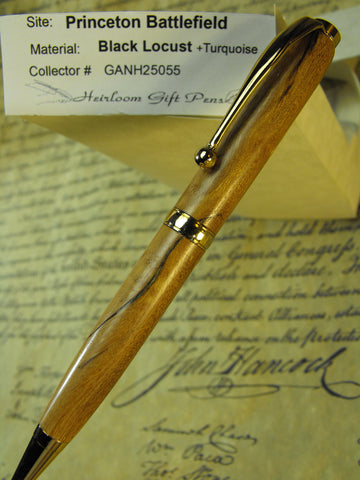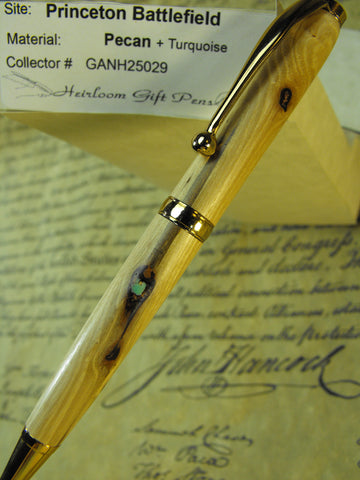Military - Collection
These are not just pens, they are a piece of history that you use and carry with you, — as a pen.
Imagine the look on their face when your history loving military friend or relative realize what you just gave them. You can be assured that from elementary students and teachers to a U.S. President and First Lady — with law students, Governors, Ambassadors, authors and Nobel laureates in between — my pens have been well received. A state government was so impressed with my pens that they were used as official gifts on multiple international junkets. At a book signing, I was sitting behind the author that had one of my pens when the next person in line saw the pen and with pride pulled one out of his pocket and said “ I have a history pen too, it was given to me as a gift”
So what is so good about these pens?
The Pen
-
You will find the warmth of the wood in your hand more pleasing than any other material — most people do, and it is a handsome material — subtly grains or dramatically patterned — like people, no two can be exactly alike, so you should look through a number of them to find one that matches their personality (or yours). And then there is the feeling of touching history, that connection to something nourished in the soil of great events.
-
Because of the source, (some of these trees are no longer around) and the time it takes me to make them, they will be inherently rare. No matter how often you give them you will never be giving “the same old pen”.
-
You can write and write, to your hearts content and just replace the cartridge, and even change the color if you like, because I use a Cross© refill in this pen.
-
The hardware has a sealed 24 carat gold finish, alternatives are available, but gold goes with everything and is appropriate to the venerated history.
-
If someday the hardware is damaged, I can replace it.
In addition to the pen
-
The pen comes in a gold foiled box with a clear cover nested on a little pen pillow with the history documents on display behind. This makes it suitable for presentation and display.
-
Just in case you and yours need to brush up on your history, I include is a 5” x 8” pamphlet, printed on archival quality parchment like paper, giving a brief history related to the Pen, this pamphlet also enhances the display of the pen as it sits in the box.
-
For you I include a signed warrant of authenticity with pictures of this, individually numbered, pen (for the doubters) on that same document I have spaces for each successive owner to sign, recording the history of this pen into the future. (some day you will be great-great grand something or other who passed this pen to great grand so and so - who passed it on to so and so -who is now passing it on. That is the plan anyway.) Traditions need to start somewhere why not with you?
-
If you or yours should ever need it as proof, I keep high resolution photos of each pen with its unique grain pattern, in my numbered registry of my history pens.
The History
-
With this pen you and yours will be holding and using a history bridge. From the past, in the present, and into the future. It is to be used and inspire, — and then given away to do the same again. Your pen comes from history, you become part of its history, and you pass it on for others to do the same. Your pen has meaning, it retains its meaning, and its succession of owners add to its meaning.
-
Your students — Your teachers — Your History lovers —Your politicians — Your Lawyers — Your ….. how often do they — do we, get to touch, hold, use a little piece of history. This is why I make these — this is their purpose.
This collection would include sites of military interest such as:
Washington Crossing for its role in starting the “Ten Crucial Days” of the American War of Independence.
The two Battles of Trenton the pivot point in the American Revolution that snatched victory from the jaws of certain defeat in the “Ten Crucial Days .“
The Battle of Princeton the third battle of the “Ten Crucial Days “especially significant to the US Marine Corps as the first land battle in which they recorded casualties.
The Mercer Oak as a Witness tree to the Battle of Princeton.
Valley Forge for its place in history where the continental line was turned into a formidable Army.
Monmouth Battlefield, the longest, hottest, battle of the War of Independence and the first after Valley Forge that proved to the British that this new American force could hold its own against the best they had to offer.
The Tennent Oak as a witness to the Battle of Monmouth.
Summerseat, Washington’s Headquarters and home of Robert Morris, “The Financier of The Revolution” setting up the first international spy network for the Americans, supplying the war effort when others failed and selling the first American War Ship, the USS Alfred, to the US Navy.
Brandywine Battlefield where in an attempt to prevent the United Stated Capital, Philadelphia, from being captured General George Washington and his troops faced off with General Sir William Howe and his British and Hessian solders in the Battle of Brandywine, the largest battle of the American Revolution, one that encompassed more troops over more land than any combat fought on American soil until the Civil War.
- Page 1 of 5
- Next



